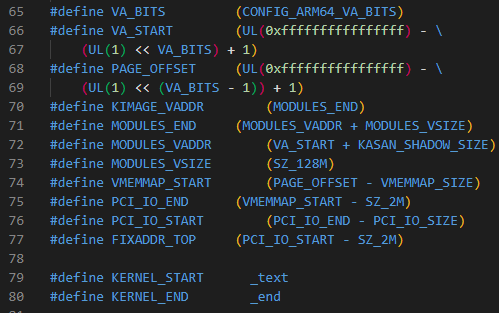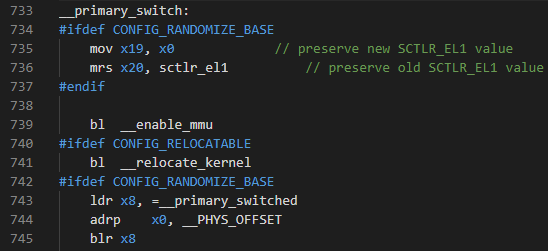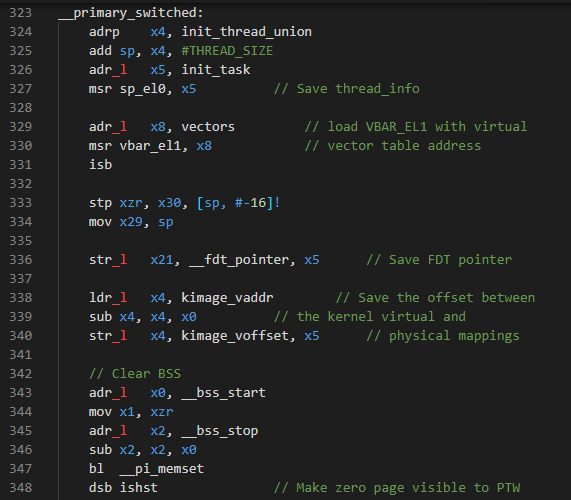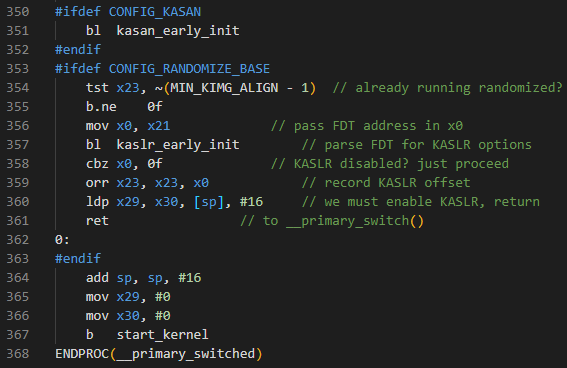
从启动引导程序 bootloader(uboot)跳转到 Linux 内核后,Linux 内核开始启动,今天我们分析一下 Linux 内核启动入口。
跳转过去初始化肯定是在汇编文件中,根据架构可以选择不同的平台,这里看一下链接汇编文件:
linux4.14/arch/arm/kernel/vmlinux.lds.S
这里可以看到链接时候 Linux 入口是 stext 段,这里是启动引导程序跳转过来的第一段Linux 代码:

第一:Linux入口地址
我们先看一下入口地址的确定,同一文件。
SECTIONS
{
/*
* XXX: The linker does not define how output sections are
* assigned to input sections when there are multiple statements
* matching the same input section name. There is no documented
* order of matching.
*
* unwind exit sections must be discarded before the rest of the
* unwind sections get included.
*/
/DISCARD/ : {
*(.ARM.exidx.exit.text)
*(.ARM.extab.exit.text)
ARM_CPU_DISCARD(*(.ARM.exidx.cpuexit.text))
ARM_CPU_DISCARD(*(.ARM.extab.cpuexit.text))
ARM_EXIT_DISCARD(EXIT_TEXT)
ARM_EXIT_DISCARD(EXIT_DATA)
EXIT_CALL
#ifndef CONFIG_MMU
*(.text.fixup)
*(__ex_table)
#endif
#ifndef CONFIG_SMP_ON_UP
*(.alt.smp.init)
#endif
*(.discard)
*(.discard.*)
}
. = PAGE_OFFSET + TEXT_OFFSET;
.head.text : {
_text = .;
HEAD_TEXT
}
这个 SECTIONS 比较长,只放一部分。在这里有个比较重要的东西:
. = PAGE_OFFSET + TEXT_OFFSET;
这一句表示了 Linux 系统真正的启动地址。
PAGE_OFFSET 是 Linux 内核空间的虚拟起始地址,定义在:

linux4.14/arch/arm64/include/asm/memory.h

注意,这里的地址都很重要,很多地方会用到。当然,这里的地址可能会随着 Linux 内核版本的不同和硬件的不同,会变化。这里没有一个具体的数,因为 VA_BITS 中的数字是可选的,大家可以根据自己的平台算一下。
TEXT_OFFSET 定义在:
linux4.14/arch/arm/Makefile 中:


这个值一般是 0x00008000 ,算出 PAGE_OFFSET 后加上这个值就是 Linux 内核的起始地址。
修改这个偏移量就可以使Linux内核拷贝到不同的地址,自己修改注意内存对齐。
第二:stext 段
从上面的ENTRY(stext)可以知道,一开始是运行stext段,这个段内的代码是 start_kernel 函数前汇编环境的初始化。
linux4.14/arch/arm64/kernel/head.S

preserve_boot_args 保存 bootloader 传递过来的参数。
el2_setup 是设置 Linux 启动模式是 EL2。Linux 有 EL0、EL1、EL2、EL3 四种异常启动模式,这里设置一开始是 EL2,EL2 支持虚拟内存技术,然后注释说明后面又退回 EL1,在 EL1 启动 kernel。EL3 一般是只在安全模式使用。
set_cpu_boot_mode_flag 保存上面 cpu 的启动模式。
__create_page_tables 创建页表。
__cpu_setup 初始化CPU,这里主要是初始化和 MMU 内存相关的 CPU 部分。
__primary_switch 这里会进行跳转。
在同一个文件中,会跳转到这里,739 行开启了MMU。然后最重要的是跳转到
__primary_switched 函数。先把 __primary_switched 地址放到 x8 寄存器中,再跳转到 x8,也就是跳转到 __primary_switched。

接下来分析 __primary_switched 函数:


324-327 初始化了 init 进程的内存信息,开辟了内存空间。
329-334 设置了向量表。
336-340 保存了FDT,也就是 flat device tree 。
342-348 清除了BSS 段,我们知道一般是内存四区:堆区、栈区、全局区、代码区。其中全局区可以再分为 data 段和 BSS 段,BSS 段存储了未初始化的变量,这里将BSS段进行清零操作,否则内存中的值是不确定的,这是一个传统操作。
367 行跳转到了我们熟悉的 start_kernel,就可以看下面这篇文章:
上次我们写过了 Linux 启动详细流程,这次单独解析 start_kernel 函数。
如下请参考注释:
Linux kernel-6.1/init/main.c
asmlinkage __visible void __init __no_sanitize_address start_kernel(void)
{
char *command_line;
char *after_dashes;
set_task_stack_end_magic(&init_task);/*设置任务栈结束魔术数,用于栈溢出检测*/
smp_setup_processor_id();/*跟 SMP 有关(多核处理器),设置处理器 ID*/
debug_objects_early_init();/* 做一些和 debug 有关的初始化 */
init_vmlinux_build_id();
cgroup_init_early();/* cgroup 初始化,cgroup 用于控制 Linux 系统资源*/
local_irq_disable();/* 关闭当前 CPU 中断 */
early_boot_irqs_disabled = true;
/*
* Interrupts are still disabled. Do necessary setups, then
* enable them.
* 中断关闭期间做一些重要的操作,然后打开中断
*/
boot_cpu_init();/* 跟 CPU 有关的初始化 */
page_address_init();/* 页地址相关的初始化 */
pr_notice("%s", linux_banner);/* 打印 Linux 版本号、编译时间等信息 */
early_security_init();
/* 系统架构相关的初始化,此函数会解析传递进来的
* ATAGS 或者设备树(DTB)文件。会根据设备树里面
* 的 model 和 compatible 这两个属性值来查找
* Linux 是否支持这个单板。此函数也会获取设备树
* 中 chosen 节点下的 bootargs 属性值来得到命令
* 行参数,也就是 uboot 中的 bootargs 环境变量的
* 值,获取到的命令行参数会保存到 command_line 中
*/
setup_arch(&command_line);
setup_boot_config();
setup_command_line(command_line);/* 存储命令行参数 */
/* 如果只是 SMP(多核 CPU)的话,此函数用于获取
* CPU 核心数量,CPU 数量保存在变量 nr_cpu_ids 中。
*/
setup_nr_cpu_ids();
setup_per_cpu_areas();/* 在 SMP 系统中有用,设置每个 CPU 的 per-cpu 数据 */
smp_prepare_boot_cpu(); /* arch-specific boot-cpu hooks */
boot_cpu_hotplug_init();
build_all_zonelists(NULL);/* 建立系统内存页区(zone)链表 */
page_alloc_init();/* 处理用于热插拔 CPU 的页 */
/* 打印命令行信息 */
pr_notice("Kernel command line: %s\n", saved_command_line);
/* parameters may set static keys */
jump_label_init();
parse_early_param();/* 解析命令行中的 console 参数 */
after_dashes = parse_args("Booting kernel",
static_command_line, __start___param,
__stop___param - __start___param,
-1, -1, NULL, &unknown_bootoption);
print_unknown_bootoptions();
if (!IS_ERR_OR_NULL(after_dashes))
parse_args("Setting init args", after_dashes, NULL, 0, -1, -1,
NULL, set_init_arg);
if (extra_init_args)
parse_args("Setting extra init args", extra_init_args,
NULL, 0, -1, -1, NULL, set_init_arg);
/* Architectural and non-timekeeping rng init, before allocator init */
random_init_early(command_line);
/*
* These use large bootmem allocations and must precede
* kmem_cache_init()
*/
setup_log_buf(0);/* 设置 log 使用的缓冲区*/
vfs_caches_init_early(); /* 预先初始化 vfs(虚拟文件系统)的目录项和索引节点缓存*/
sort_main_extable();/* 定义内核异常列表 */
trap_init();/* 完成对系统保留中断向量的初始化 */
mm_init();/* 内存管理初始化 */
ftrace_init();
/* trace_printk can be enabled here */
early_trace_init();
/*
* Set up the scheduler prior starting any interrupts (such as the
* timer interrupt). Full topology setup happens at smp_init()
* time - but meanwhile we still have a functioning scheduler.
*/
sched_init();/* 初始化调度器,主要是初始化一些结构体 */
if (WARN(!irqs_disabled(),
"Interrupts were enabled *very* early, fixing it\n"))
local_irq_disable();/* 检查中断是否关闭,如果没有的话就关闭中断 */
radix_tree_init();/* 基数树相关数据结构初始化 */
maple_tree_init();
/*
* Set up housekeeping before setting up workqueues to allow the unbound
* workqueue to take non-housekeeping into account.
*/
housekeeping_init();
/*
* Allow workqueue creation and work item queueing/cancelling
* early. Work item execution depends on kthreads and starts after
* workqueue_init().
*/
workqueue_init_early();
rcu_init();/* 初始化 RCU,RCU 全称为 Read Copy Update(读-拷贝修改) */
/* Trace events are available after this */
trace_init();/* 跟踪调试相关初始化 */
if (initcall_debug)
initcall_debug_enable();
context_tracking_init();
/* init some links before init_ISA_irqs() */
/* 初始中断相关初始化,主要是注册 irq_desc 结构体变
* 量,因为 Linux 内核使用 irq_desc 来描述一个中断。
*/
early_irq_init();
init_IRQ();/* 中断初始化 */
tick_init();/* tick 初始化 */
rcu_init_nohz();
init_timers();/* 初始化定时器 */
srcu_init();
hrtimers_init();/* 初始化高精度定时器 */
softirq_init();/* 软中断初始化 */
timekeeping_init();
time_init();/* 初始化系统时间 */
/* This must be after timekeeping is initialized */
random_init();
/* These make use of the fully initialized rng */
kfence_init();
boot_init_stack_canary();
perf_event_init();
profile_init();
call_function_init();
WARN(!irqs_disabled(), "Interrupts were enabled early\n");
early_boot_irqs_disabled = false;
local_irq_enable();/* 使能中断 */
kmem_cache_init_late();/* slab 初始化,slab 是 Linux 内存分配器 */
/*
* HACK ALERT! This is early. We're enabling the console before
* we've done PCI setups etc, and console_init() must be aware of
* this. But we do want output early, in case something goes wrong.
*/
/* 初始化控制台,之前 printk 打印的信息都存放
* 缓冲区中,并没有打印出来。只有调用此函数
* 初始化控制台以后才能在控制台上打印信息。
*/
console_init();
if (panic_later)
panic("Too many boot %s vars at `%s'", panic_later,
panic_param);
lockdep_init();
/*
* Need to run this when irqs are enabled, because it wants
* to self-test [hard/soft]-irqs on/off lock inversion bugs
* too:
*/
locking_selftest();/* 锁自测 */
/*
* This needs to be called before any devices perform DMA
* operations that might use the SWIOTLB bounce buffers. It will
* mark the bounce buffers as decrypted so that their usage will
* not cause "plain-text" data to be decrypted when accessed.
*/
mem_encrypt_init();
#ifdef CONFIG_BLK_DEV_INITRD
if (initrd_start && !initrd_below_start_ok &&
page_to_pfn(virt_to_page((void *)initrd_start)) < min_low_pfn) {
pr_crit("initrd overwritten (0x%08lx < 0x%08lx) - disabling it.\n",
page_to_pfn(virt_to_page((void *)initrd_start)),
min_low_pfn);
initrd_start = 0;
}
#endif
setup_per_cpu_pageset();
numa_policy_init();
acpi_early_init();
if (late_time_init)
late_time_init();
sched_clock_init();
/* 测定 BogoMIPS 值,可以通过 BogoMIPS 来判断 CPU 的性能
* BogoMIPS 设置越大,说明 CPU 性能越好。
*/
calibrate_delay();
pid_idr_init();
anon_vma_init();/* 生成 anon_vma slab 缓存 */
#ifdef CONFIG_X86
if (efi_enabled(EFI_RUNTIME_SERVICES))
efi_enter_virtual_mode();
#endif
thread_stack_cache_init();
cred_init();/* 为对象的每个用于赋予资格(凭证) */
fork_init();/* 初始化一些结构体以使用 fork 函数 */
proc_caches_init();/* 给各种资源管理结构分配缓存 */
uts_ns_init();
key_init();/* 初始化密钥 */
security_init();/* 安全相关初始化 */
dbg_late_init();
net_ns_init();
vfs_caches_init();/* 虚拟文件系统缓存初始化 */
pagecache_init();
signals_init();/* 初始化信号 */
seq_file_init();
proc_root_init();/* 注册并挂载 proc 文件系统 */
nsfs_init();
/* 初始化 cpuset,cpuset 是将 CPU 和内存资源以逻辑性
* 和层次性集成的一种机制,是 cgroup 使用的子系统之一
*/
cpuset_init();
cgroup_init();/* 初始化 cgroup */
taskstats_init_early();/* 进程状态初始化 */
delayacct_init();
poking_init();
check_bugs();/* 检查写缓冲一致性 */
acpi_subsystem_init();
arch_post_acpi_subsys_init();
kcsan_init();
/* Do the rest non-__init'ed, we're now alive */
/* 调用 rest_init 函数 */
/* 创建 init、kthread、idle 线程 */
arch_call_rest_init();
prevent_tail_call_optimization();
}